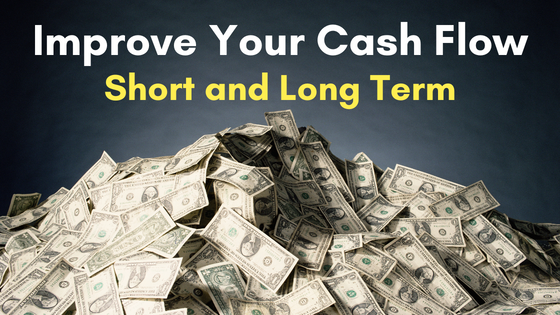
It Starts with Management
The book begins by presenting the problem of business owners feeling like their business is running them (and not the other way around). Cunningham tells us that we can be the Owners of our business rather than just the Operators of our business by following the guidance of the book. The first main concept to be introduced is that management is the driving force of business outcomes. Meaning: management makes decisions –> which create business activities –> which produce financials results. Every financial result begins with a management decision (or non-decision). Which reminds us that the ultimate responsibility of our financial outcomes in our business rests with us, the business owner. Cunningham states that if business is not doing well, it’s your own fault as management! Ouch! Does that hurt a little? Read on.
What Gets Measured, Gets Managed
Measuring the results of your business activities is required to know if you need to make changes in your business. Cunningham says,
“Your Financial results are simply a numerical reflection of the business decisions and operating activities in your business.”
Measuring is done by using your financial report card (business financial statements) to provide “business optics”. Business optics is just a fancy way of saying “useful measurements”. A business owner that relies on luck and their “gut” to make decisions may get along fine in the short term but will not be able to maintain a successful business over time. Cunningham describes that he once heard that “gut” stood for “gave up thinking”, which is what he proposes NOT to do. He says that measuring and thinking are the two best uses of your time as a business owner. Don’t stop those two things, and you will be on the right path.
But measuring by itself isn’t helpful if you don’t know what you are comparing your numbers to. For example, if you went to the doctor to get your blood pressure taken, and she said, “it’s 200” how do you know if that’s a good or bad blood pressure reading if you don’t have a comparison point? We need a guide or metric to compare our financial numbers to if we want our measurement to be helpful for running our businesses. The best way to improve your own business is to use your own results as a basis of measurement. Therefore, tracking your own financial trends and historical results, will help you understand what is good or bad for your business. Cunningham suggests keeping records of each of the past 18 consecutive months and the last five years of financial information on one spreadsheet, so you can see long-term trends and progress. A Trend is your Friend 😊
The Revenue Obsession
There’s a myth in the business world that revenue is the main number to concern yourself with: THE MORE REVENUE THE BETTER! If I were to compare this to personal finance, this would be the same as trying to pursue the best salary you can possibly attain. But we know that just because you make a big salary doesn’t mean you will be wealthy in the long-term. It IS possible for people to make incredible money and spend it all (and then some) in a short period of time. Just look at all the actors, lottery winners, and professional athletes that end up filing for bankruptcy! The same concept applies in business, and if you focus too much on revenue and not PROFIT and CASH, you might eventually file for bankruptcy too.
REVENUE – EXPENSES = PROFIT
The difference between Revenue and Expenses is Profit. Controlling expenses is just as important (if not MORE important) than growing revenue for a sustainable business model. Lowering expenses can be much quicker and easier than generating more revenue too. However, business owners get caught in the trap of “pimping out” their businesses (as described by Cunningham). This is where they go and buy the fanciest thing when they need something for their business. For example, a fancy new $4,000 computer when an $800 one will do. Or a spanking new delivery truck, when a used one could have worked just fine. It’s important to remember that when you spend money on your business, that’s an investment into your business, and you want that investment to be returning something back to you. When you buy assets, those assets need to be DOING something for you…not just sitting there looking pretty! So, invest in assets only to the point that they will HELP you make money. Ask yourself
“Do I need it? Will it help me make more money?”
If the answer is no, don’t purchase it.
Cash is Still King
Did you know that Profit is theory? Please don’t ever make the mistake of thinking that the profit on your income statement should equal the amount of cash in your bank. Profit is a theoretical number in what you earned minus what you spent but timing can throw off the collection and payment of cash. Accrual accounting is a little more theoretical than a cash-basis accounting method, but don’t trust either profit number to equate to cash.
However, every business owner with good optics into their financial information will be able to see where their cash is and how it is being used. Cash is generated/used in three different ways: Operating, Investing, and financing:
- Operating is the cash flow coming from the direct operations of your business (think selling your goods& services, paying rent, paying your employees, etc.).
- Investing is when you buy assets for your business or sell assets.
- Financing is when you receive money from a bank or investor and repay loans.
You always want your operating cash flow to be positive – this means that your business is making more money than it is spending (in cash terms). Most businesses using cash-basis financial statements will not look at a statement of cash flows, but some reconciliation between your balance sheet, income statement, and your cash situation should be performed on a regular basis (i.e. monthly).
Without cash or access to cash through financing means, a business with fail. Get familiar with the ins and outs of your cash, make decisions to increase cash, and your business’s chances of survival increase dramatically!
Opinion:
This book was recommended to me by a business friend, Joanna Sapir, after I shared with her my vision for helping small businesses succeed with their finances. I am grateful to Joanna for recommending this book to me because I probably wouldn’t have known it existed without the recommendation! Cunningham and I think very similarly when it comes to running a business. I believe this book has a lot to offer all small business owners who want long-term success (which is hopefully ALL of them). Now, Cunningham is trying to get people to buy his CFO Scoreboard product in the book, but it’s not overly pushy. I can see past it. I can do the same thing with Excel, so I don’t need his scoreboard.
This book can be a little “harsh” in some places, and it calls out the business “gurus” that will tell you anything about running a business just to sell you a book. I really appreciate Cunningham’s straightforward approach to taking responsibility and owning up to our decisions as it directly affects our business success. It flies in the face of much “positive vibes only” business culture where you just need to “visualize” success and it will “manifest” itself. This book is not “woo-woo” at all. In fact, I’m pretty sure Cunningham doesn’t even know what that means! 😊
If you want to run your business like Warren Buffet would, then I recommend applying the measuring and thinking principles in this book.
If you need help with the measuring, I help my Virtual CFO clients with the nitty-gritty task of taking the financial statements and turning them into business optics. We dig into their finances and figure out how to cut expenses to increase profits, and I assist in planning and forecasting for long term sustainability. I also help clients figure out what actions to take when the results are not what they want. If you want someone alongside of you while you implement the strategies of this book, I would love to be that person. Schedule a time to chat with me!
Buy or Borrow?
Unfortunately, you’ll have a hard time finding this book in any library, BUT I’d recommend buying it anyway. I have already read it twice, and I think I will re-read it many more times as the years go on! You can purchase HERE.
Want help on your blueprint for financial success?
Are you ready to gain control and clarity in your business finances? Ready to take the next step to maximize profits and make confident financial decisions? We’d love to talk with you about your financial needs and help you make a path to your goals. Let’s talk.
Disclosure: Some of the links on this page are Amazon affiliate links, meaning that as an Amazon Associate I earn from qualifying purchases at no additional cost to you.
Disclaimer: This blog and the linked videos are intended for educational purposes and should not be taken as legal or tax advice. You should consult with your financial professionals about your unique financial situation before acting on anything discussed in these videos. Clara CFO Group, LLC is providing educational content to help small business owners become more aware of certain issues and topics, but we cannot give blanket advice to a broad audience.






